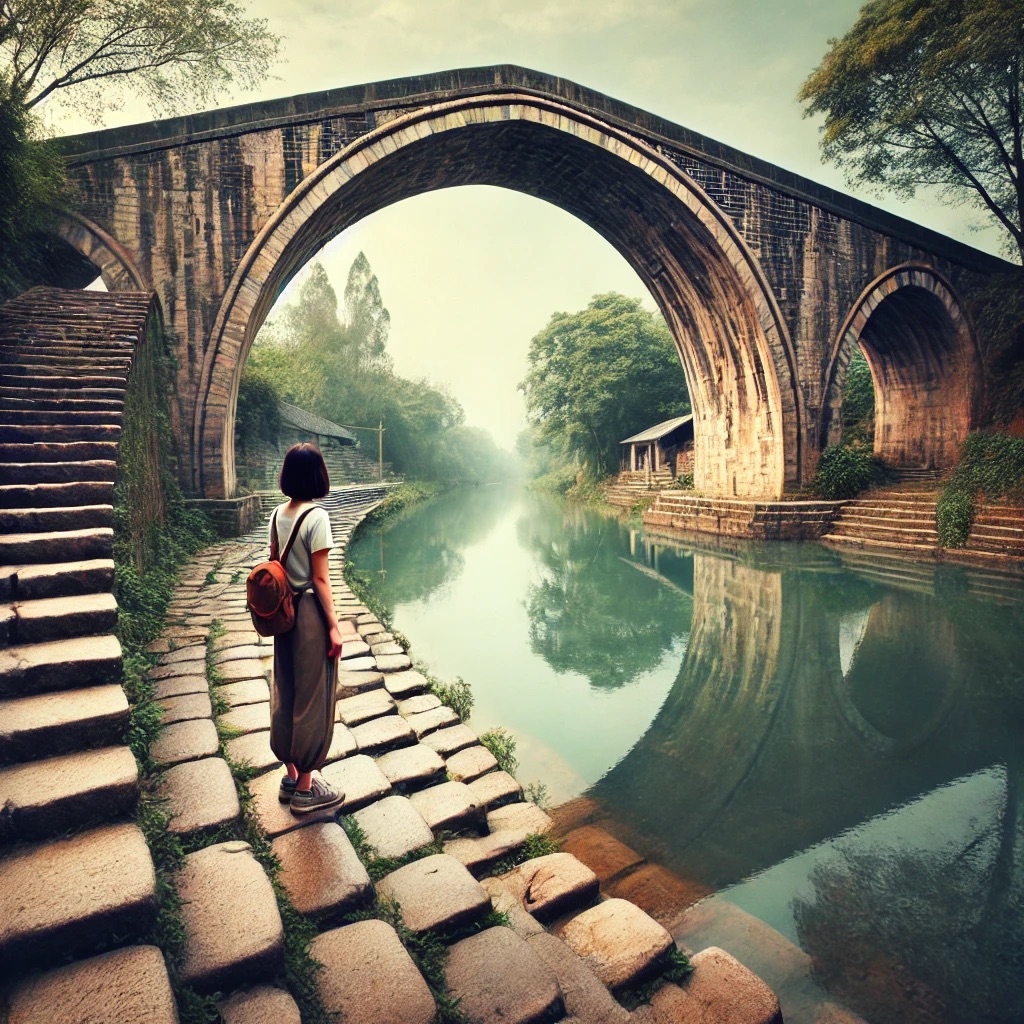ChatGPT:
Torcello is a small, quiet island located in the northern part of the Venetian Lagoon, about 10 kilometers from Venice, Italy. It’s one of the oldest continuously populated regions in the area, with a rich history that dates back to the early Middle Ages.
Torcello was once a bustling and prosperous settlement, much larger and more important than Venice itself. At its peak during the 7th to 10th centuries, it was a thriving center of commerce, with a population that possibly reached 20,000. However, due to a combination of factors, including the silting up of the lagoon, malaria outbreaks, and the rise of Venice as a dominant power, Torcello’s population and significance declined dramatically over the centuries.
Despite its small size and quiet demeanor, Torcello’s rich history and well-preserved landmarks make it a fascinating destination for those interested in the early history of the Venetian Lagoon and its transition from a thriving community to a peaceful, almost forgotten place. The island’s peacefulness offers a stark contrast to the hustle and bustle of Venice, making it a perfect day trip for visitors seeking a more contemplative experience.
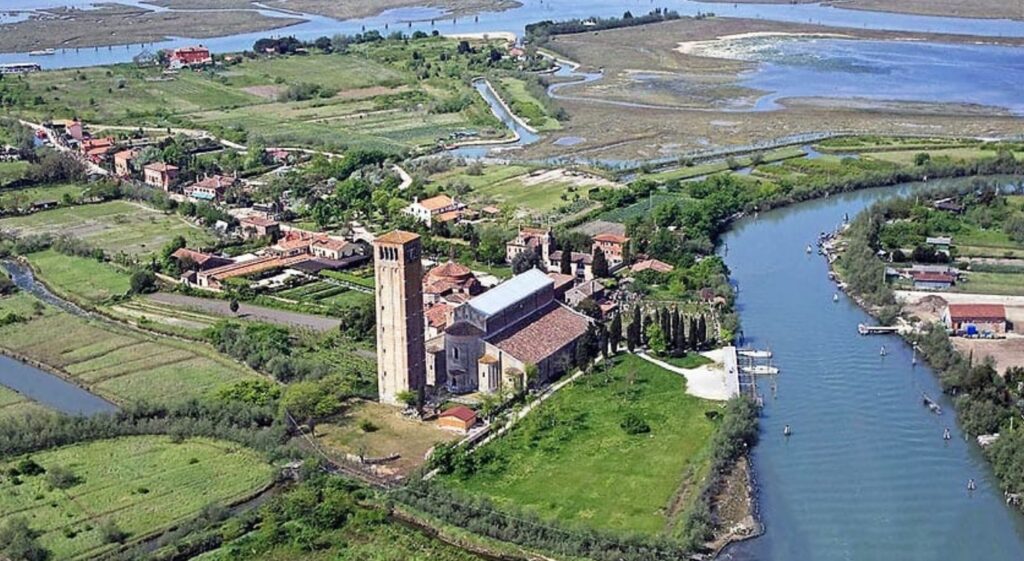
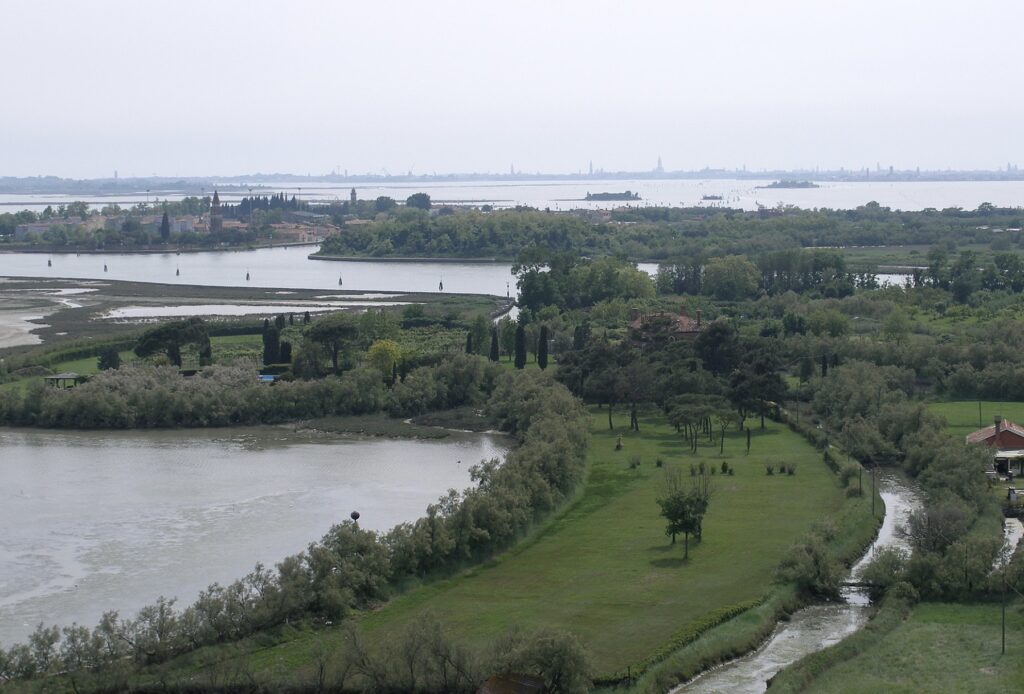
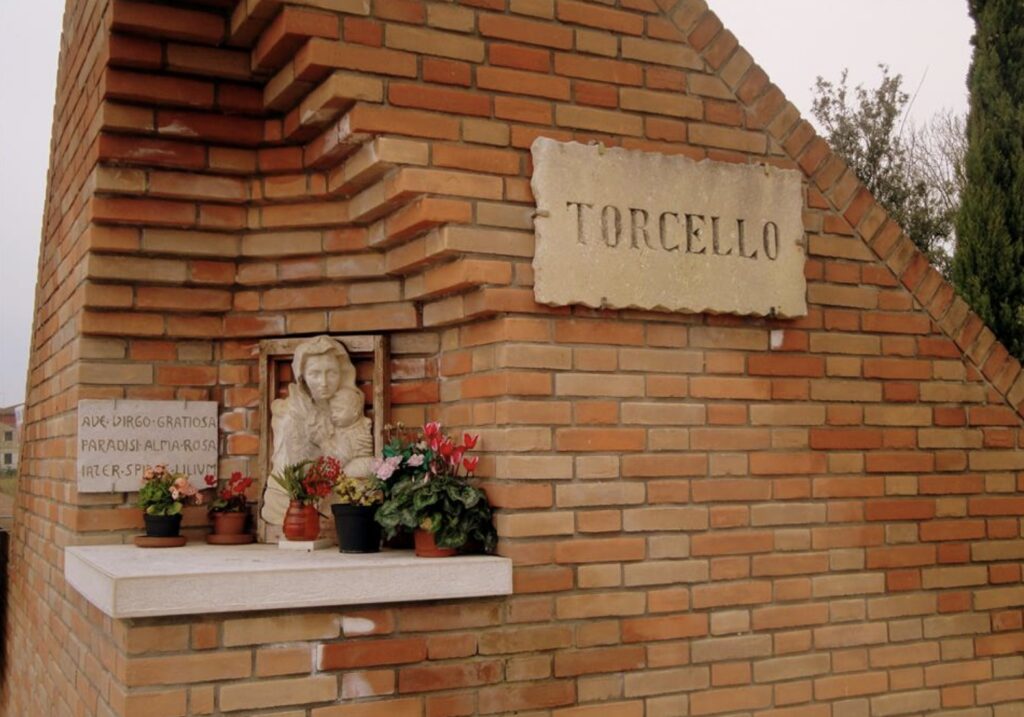
Origin of Torcello
Torcello’s origins date back to the early days of the Roman Empire. As Roman power began to decline, particularly after the sack of Rome by the Visigoths in 410 AD and subsequent barbarian invasions, many residents of the mainland fled to the safety of the Venetian Lagoon. Torcello, with its relatively high ground and safe distance from the mainland, became an ideal refuge. By the 5th and 6th centuries, it was established as one of the earliest settlements in the lagoon.
Early History and Rise of Torcello
By the 7th century, Torcello had grown into a flourishing and prosperous community. It became a vital center of commerce and agriculture, benefiting from its strategic position along the trade routes between the Byzantine Empire and Western Europe. The island’s proximity to the sea allowed it to serve as a hub for trade, especially in salt, which was a valuable commodity at the time.
Torcello quickly became the most important settlement in the Venetian Lagoon, even more so than Venice itself, which was still in its infancy. The island’s population swelled, possibly reaching 20,000 at its height. The establishment of the Basilica di Santa Maria Assunta in 639 AD symbolized Torcello’s importance, serving as the religious and administrative heart of the lagoon.
Byzantine Influence
During its peak, Torcello was under the influence of the Byzantine Empire, which had regained control of northern Italy and the lagoon areas after the Gothic War in the 6th century. The Byzantine influence is evident in the island’s architecture, particularly in the Basilica di Santa Maria Assunta and other religious structures. The mosaics in the basilica, especially the famous Last Judgment scene, are among the finest examples of Byzantine art in Italy.
Decline of Torcello
Torcello’s decline began in the late Middle Ages. Several factors contributed to its downfall:
- Environmental Changes: The lagoon’s environment began to shift. Rivers that once flowed through the lagoon started to silt up, leading to the formation of marshes around Torcello. This created ideal conditions for malaria, which became a persistent problem for the inhabitants.
- Shift of Power to Venice: As Venice grew in power and influence, it began to eclipse Torcello. Venice’s strategic location and its increasingly dominant role in maritime trade drew people and resources away from Torcello. By the 10th century, Venice had become the primary city in the lagoon, and Torcello’s importance waned.
- Depopulation: By the 12th and 13th centuries, many of Torcello’s residents had either died from disease or migrated to Venice, seeking better opportunities. The island’s population dwindled rapidly, and by the 14th century, it had become a shadow of its former self.
- Relocation of the Bishopric: In 1689, the bishopric of Torcello was moved to Murano, further signaling the island’s decline. The remaining population was mostly involved in agriculture and fishing, and the island continued to lose its significance.
Modern Development and Legacy
By the 19th century, Torcello was largely abandoned, with only a small community remaining. However, the island’s historical and cultural significance was not forgotten. In the 20th century, efforts were made to preserve and restore the remaining buildings and artifacts.
Today, Torcello is a tranquil, almost deserted island with only a handful of permanent residents. It has become a popular destination for tourists seeking a peaceful retreat from the busy streets of Venice. The island’s ancient structures, particularly the Basilica di Santa Maria Assunta and the Church of Santa Fosca, attract visitors interested in history and art.
Torcello’s story is one of early prominence followed by a slow decline, leaving behind a landscape rich in history and cultural heritage. It stands as a testament to the shifting tides of fortune in the Venetian Lagoon, from its rise as a center of commerce to its current status as a quiet historical site.
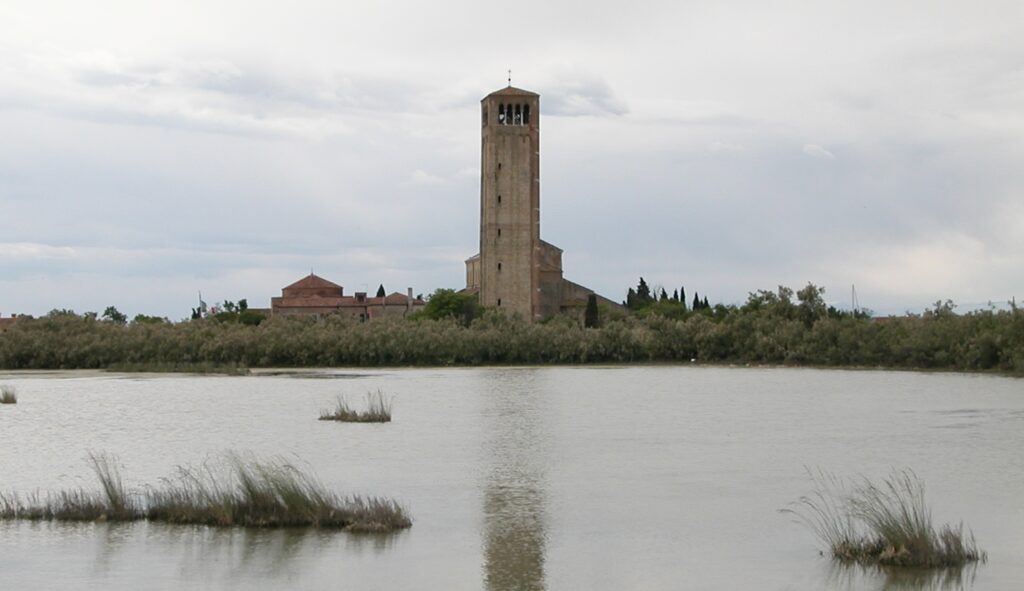
Architectural Features of Basilica di Santa Maria Assunta
The Basilica di Santa Maria Assunta on Torcello is one of the oldest religious structures in the Venetian Lagoon, with its origins dating back to 639 AD. The basilica is a prime example of Byzantine architecture, though it also incorporates elements of early Venetian style. Here are the key architectural features:
1. Exterior
- Simple Facade: The exterior of the basilica is quite austere, with a simple brick facade that contrasts with the elaborate mosaics found inside. The lack of ornamentation on the outside is typical of early Christian basilicas, focusing attention on the spiritual experience within.
- Bell Tower: The basilica’s bell tower, added in the 11th century, is a prominent feature of Torcello’s skyline. The tower is square and robust, providing both a visual anchor for the island and serving as a lookout post in earlier times. The bell tower offers panoramic views of the surrounding lagoon.
2. Interior
- Nave and Aisles: The basilica’s interior is laid out in a traditional basilica plan with a central nave flanked by two aisles. The nave is supported by a series of marble columns with Byzantine-style capitals, which are intricately carved with floral and geometric patterns.
- Apse: The semi-circular apse is one of the most striking features of the basilica. It is elevated above the nave and contains the main altar, which is framed by an ornate arch. The apse also houses some of the most important mosaics, including the depiction of the Virgin Mary.
3. Byzantine Influence
- The overall architectural style of the basilica is heavily influenced by Byzantine design, reflecting the historical ties between the Venetian Lagoon and the Byzantine Empire. This influence is particularly evident in the use of domes, the layout of the interior spaces, and the intricate decorative details.
Mosaics of Basilica di Santa Maria Assunta
The mosaics inside the Basilica di Santa Maria Assunta are among the finest examples of Byzantine art in Italy. These mosaics date primarily from the 11th and 12th centuries and cover much of the interior, particularly the apse and the west wall. Here are some of the key mosaics:
1. The Last Judgment (West Wall)
- Location: The entire west wall of the basilica
- Description: The Last Judgment mosaic is one of the most famous and striking pieces in the basilica. It covers the entire west wall and is divided into multiple horizontal registers, each depicting a different scene from the Last Judgment. The mosaic shows Christ in Majesty at the top, flanked by angels. Below Him, the dead are shown rising from their graves, being judged, and being sent either to heaven or to hell. The vivid depictions of heaven and hell are both dramatic and detailed, making this mosaic a powerful and evocative piece of religious art.
2. The Virgin Hodegetria (Apse Mosaic)
- Location: Apse
- Description: The apse mosaic features a large image of the Virgin Mary, depicted as the Hodegetria (She Who Shows the Way). Mary is shown holding the Christ Child, and the image is set against a gold background, typical of Byzantine mosaics. This representation of the Virgin is both solemn and majestic, emphasizing her role as the intercessor between the faithful and Christ.
3. Christ Pantocrator
- Location: Apse
- Description: Above the image of the Virgin Mary in the apse is a mosaic of Christ Pantocrator, a traditional Byzantine depiction of Christ as the ruler of the universe. Christ is shown with a stern expression, holding a book (the Gospels) in one hand and making a gesture of blessing with the other. The image is surrounded by a mandorla (an almond-shaped aureole), symbolizing His divine nature.
4. Scenes from the Old Testament
- Location: Various panels throughout the interior
- Description: The basilica also contains several mosaics depicting scenes from the Old Testament, including stories such as the Creation, the Expulsion from Eden, and the story of Noah’s Ark. These scenes are intricately detailed and vividly colored, providing a rich narrative that complements the more solemn religious imagery.
Artistic Significance
The mosaics of the Basilica di Santa Maria Assunta are significant not only for their beauty but also for their spiritual and theological content. They convey complex religious themes in a visually striking manner, using the characteristic gold backgrounds, detailed figures, and expressive faces typical of Byzantine mosaic art. The mosaics are designed to inspire awe and contemplation, drawing the viewer into the spiritual world they depict.
Overall, the combination of the basilica’s simple yet grand architectural design with its magnificent mosaics makes the Basilica di Santa Maria Assunta a masterpiece of early medieval religious art and architecture in the Venetian Lagoon.
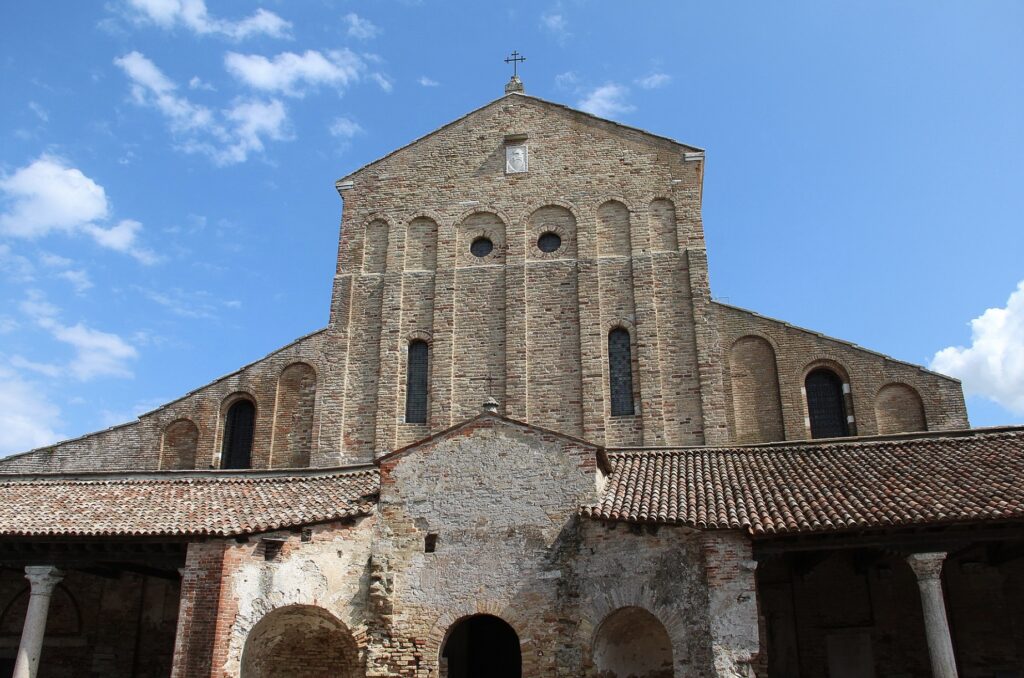
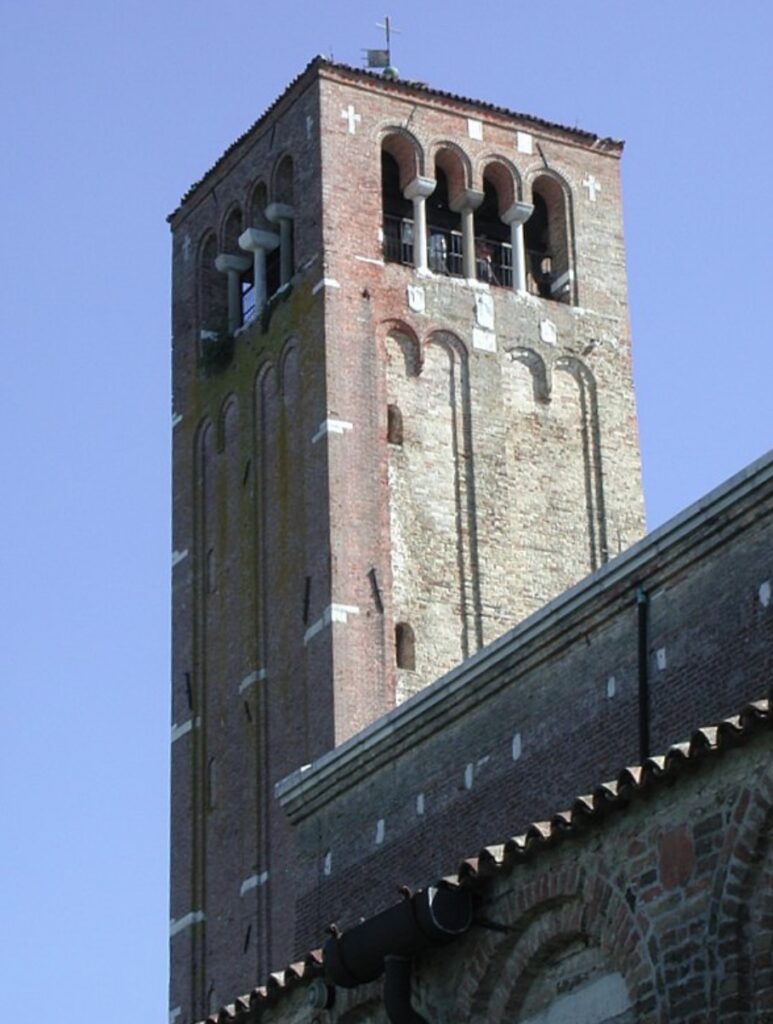
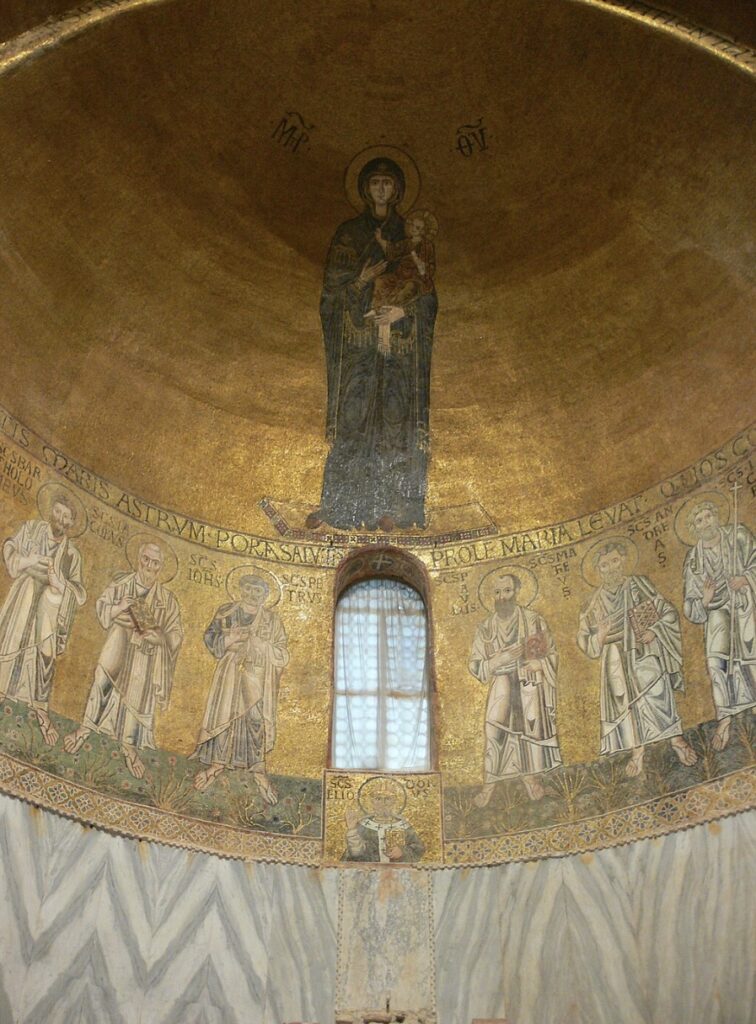

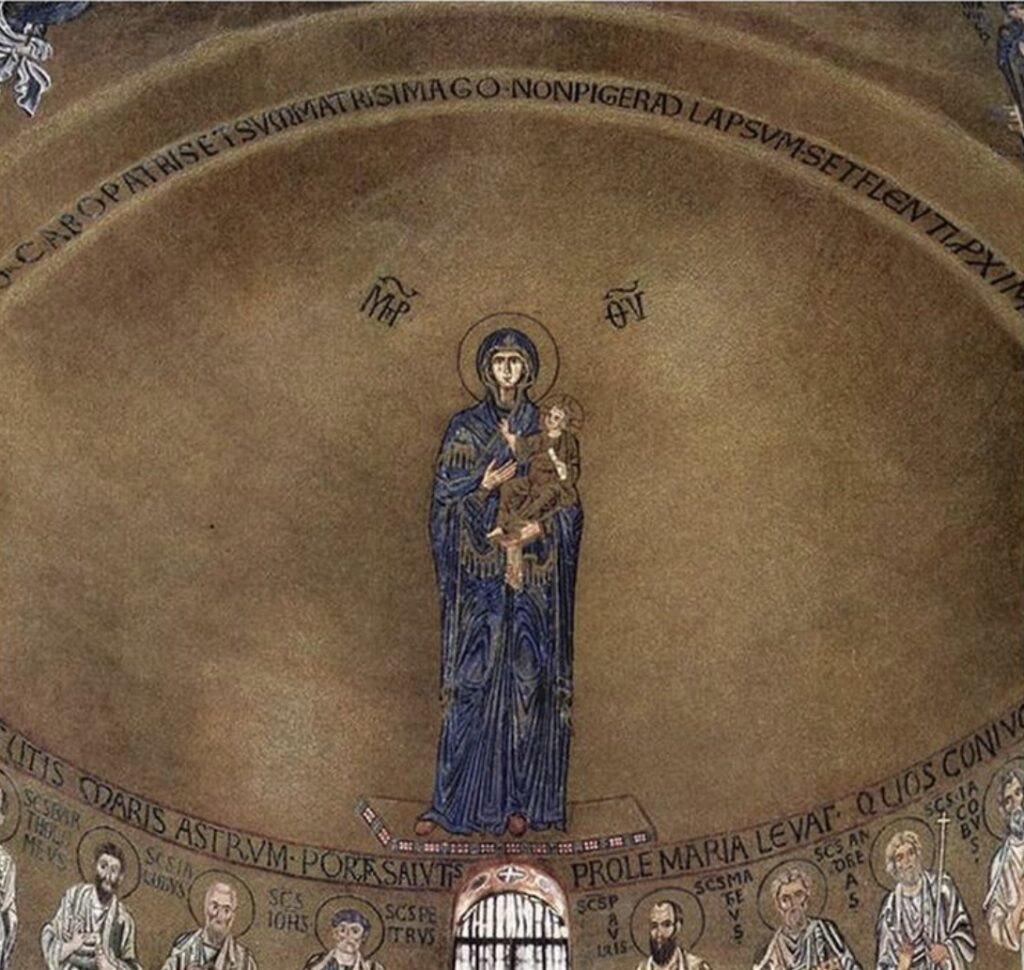
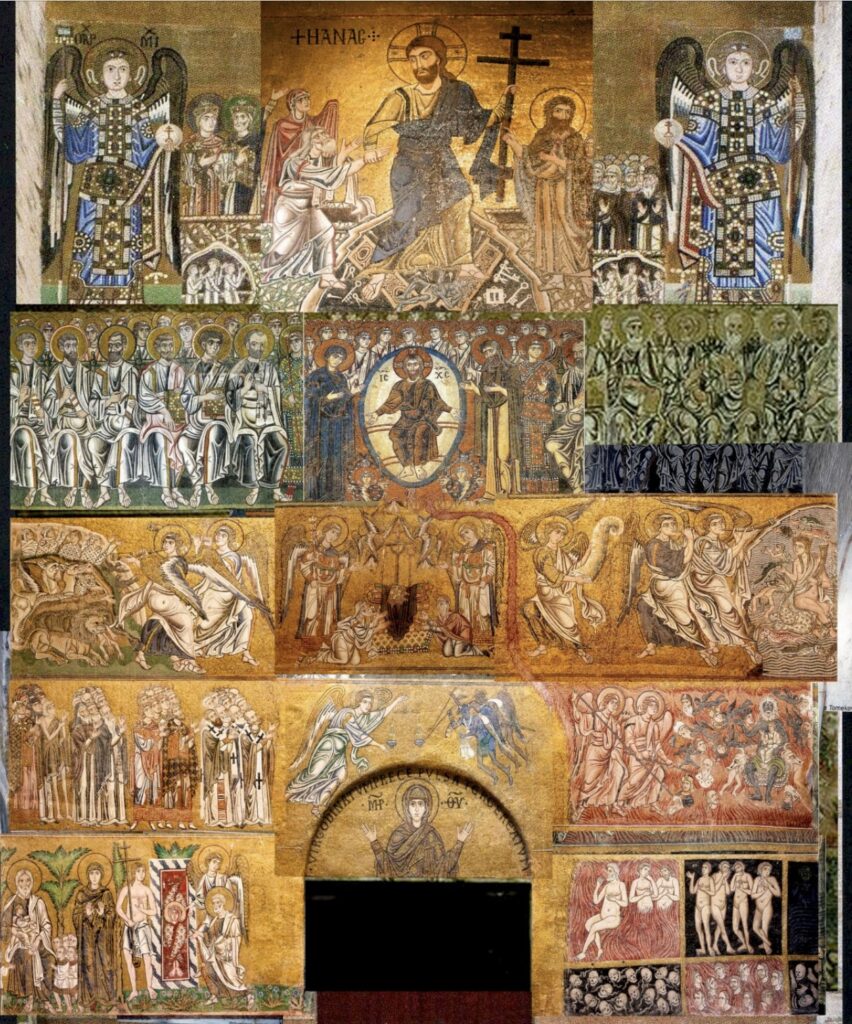
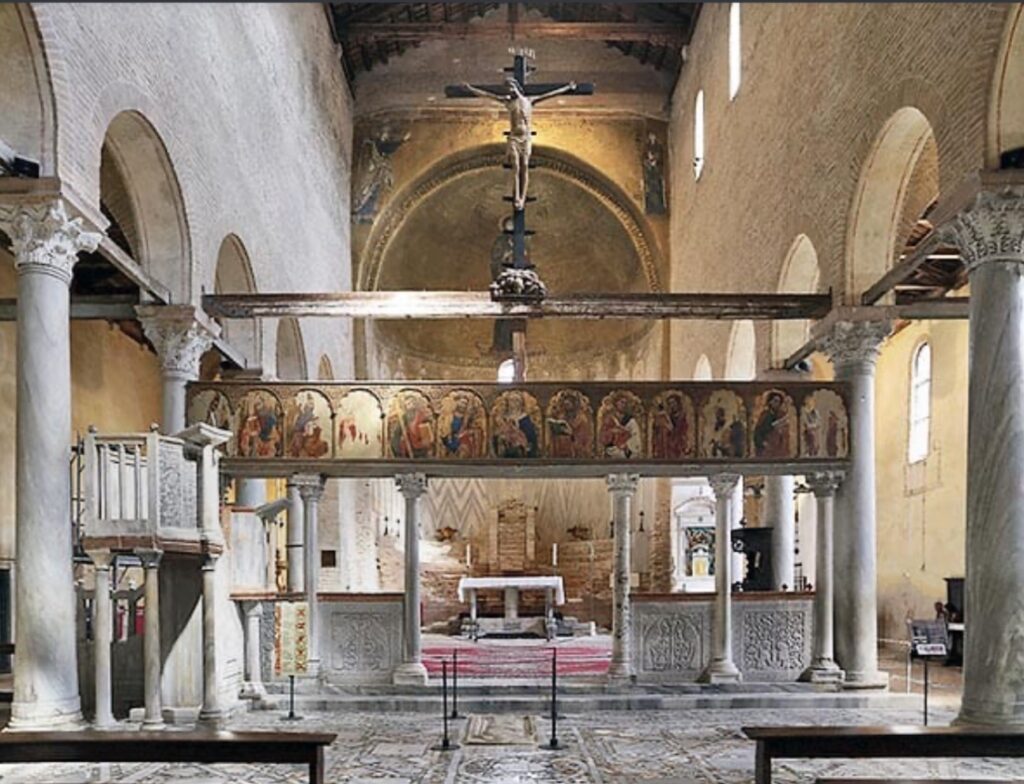
The Church of Santa Fosca on Torcello is a remarkable example of Byzantine-influenced architecture in the Venetian Lagoon. Built in the 11th century, the church is known for its unique design and harmonious proportions. Here are the key architectural features:
1. Layout and Structure
- Greek Cross Plan: The church is designed in the shape of a Greek cross, a common feature in Byzantine architecture. This means that all four arms of the cross are of equal length. The central space of the church is square, and the arms of the cross extend symmetrically from it.
- Central Dome: At the intersection of the cross, a central dome rises above the structure. The dome is supported by pendentives (triangular segments that transition the space between the circular base of the dome and the square room below), which is another typical feature of Byzantine architecture. The dome creates a sense of verticality and draws the eye upward, enhancing the spiritual experience within the church.
2. Exterior
- Simple Brick Facade: The exterior of the Church of Santa Fosca is characterized by its simplicity and lack of ornamentation. The facade is constructed of plain brick, typical of early medieval churches in the region. The simplicity of the exterior contrasts with the more elaborate interior design, emphasizing the church’s spiritual purpose over external grandeur.
- Arcaded Portico: Surrounding the church on three sides is a graceful arcaded portico. The portico is made up of slender columns with rounded arches, creating a covered walkway that adds to the church’s aesthetic appeal and provides shelter for visitors. The portico also contributes to the church’s integration with its natural surroundings, offering views of the tranquil gardens and the lagoon beyond.
3. Interior
- Harmonious Proportions: Inside, the church’s Greek cross layout creates a space that feels balanced and serene. The central dome, supported by the cross arms, gives the interior a sense of unity and cohesion. The walls are largely unadorned, focusing attention on the architectural form itself.
- Marble Columns: The interior features marble columns that support the arches and the dome. These columns are topped with capitals that are simple yet elegant, often featuring floral or geometric designs. The use of marble adds a sense of refinement to the otherwise austere interior.
4. Byzantine Influence
- Architectural Style: The Church of Santa Fosca is a quintessential example of Byzantine architectural influence in the Venetian Lagoon. Its central dome, use of pendentives, Greek cross plan, and arcaded portico all reflect the style that was prevalent in the Eastern Roman Empire during this period.
- Integration with Nature: Like many Byzantine structures, the church is designed to blend with its natural environment. The simple brickwork, the low profile of the building, and the surrounding portico all contribute to a sense of harmony between the church and the peaceful landscape of Torcello.
5. Aesthetic and Spiritual Qualities
- Sense of Tranquility: The Church of Santa Fosca is noted for its serene atmosphere, both inside and out. The simple, uncluttered design of the interior, combined with the natural light that filters through the small windows in the dome and walls, creates a peaceful environment conducive to prayer and contemplation.
- Spiritual Significance: The church’s architecture is intended to elevate the spiritual experience of visitors. The central dome symbolizes the heavens, while the symmetrical cross layout represents the universe, with the central space serving as a focal point for worship.
6. Comparison to Other Byzantine Structures
- The Church of Santa Fosca is often compared to other Byzantine churches, particularly those in Ravenna and Constantinople. However, its simpler design and more modest scale reflect its location in the Venetian Lagoon, where local resources and materials were used to adapt the grand Byzantine style to a smaller, more rural setting.
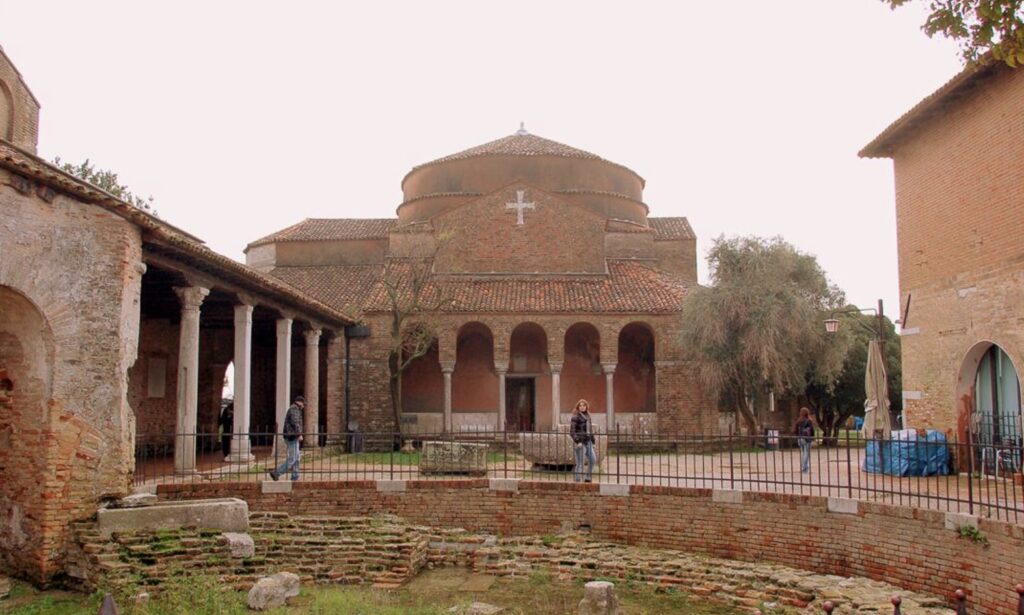
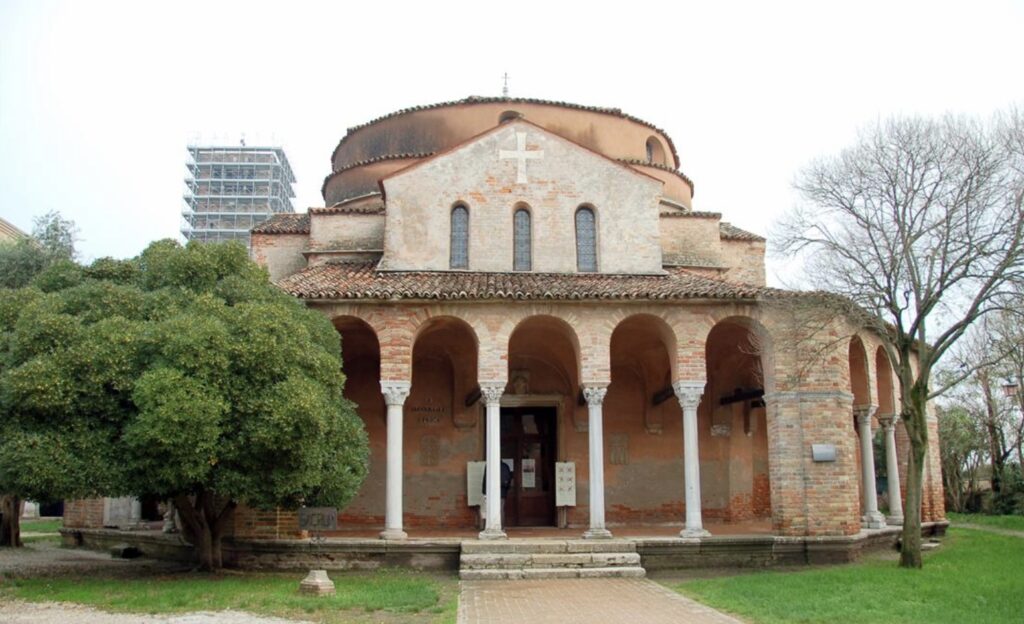
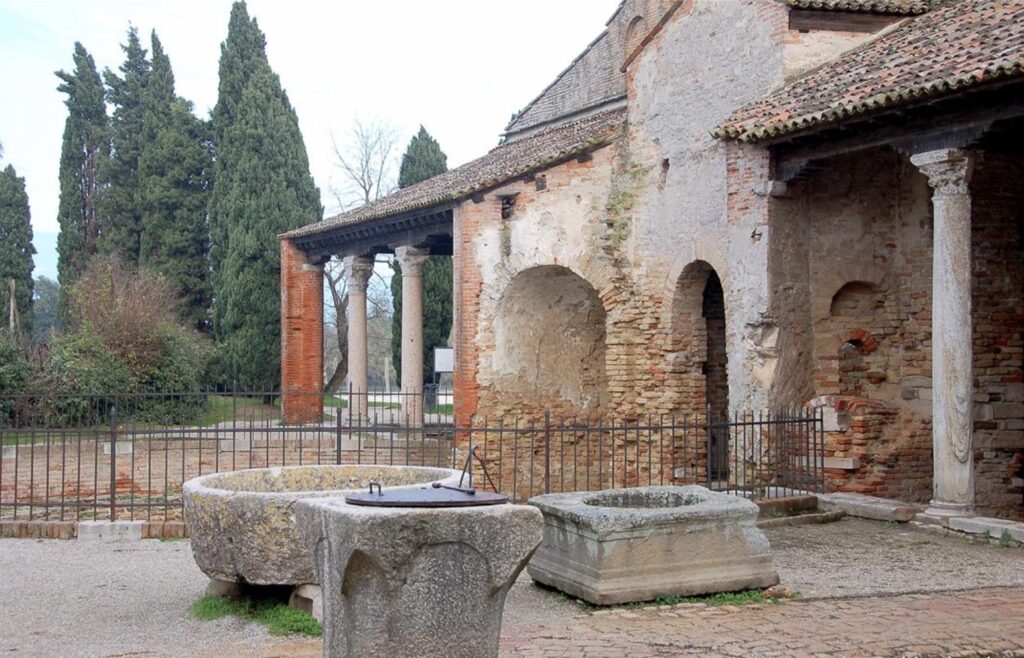
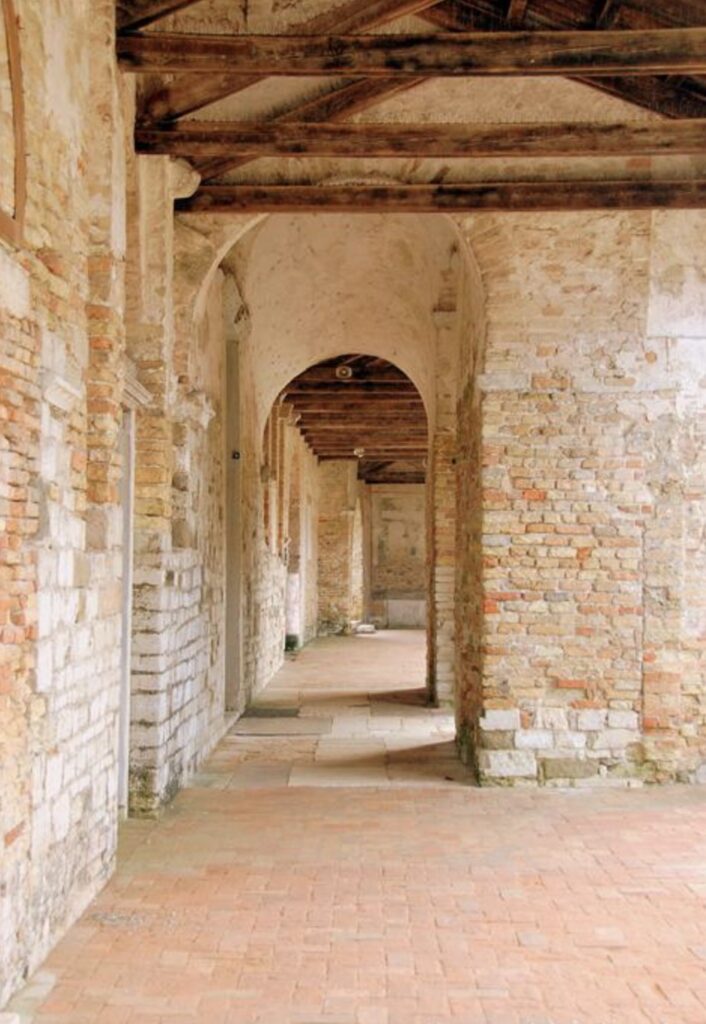
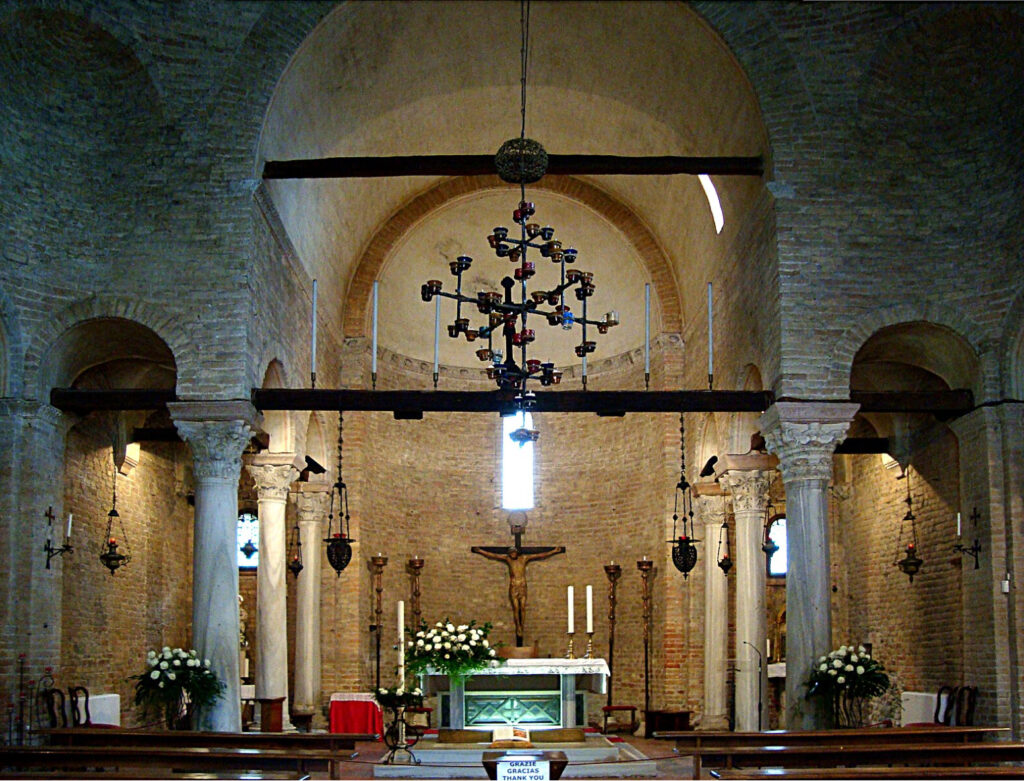
In addition to the Basilica di Santa Maria Assunta and the Church of Santa Fosca, Torcello offers a few other attractions that reflect its rich history and tranquil charm. Here are some other key sights to explore on the island:
1. Museo Provinciale di Torcello
- Description: The Provincial Museum of Torcello is housed in two historic buildings: the Palazzo dell’Archivio and the Palazzo del Consiglio. The museum’s collection includes artifacts from Torcello’s history, ranging from Roman and Byzantine relics to medieval and Renaissance pieces. The exhibits provide insight into the island’s past as a major settlement in the Venetian Lagoon, with displays of sculptures, inscriptions, ceramics, and other archaeological finds.
2. Ponte del Diavolo (Devil’s Bridge)
- Description: The Ponte del Diavolo is one of the few remaining examples of ancient Venetian bridges that have no parapets. This small, arched stone bridge spans a narrow canal and is steeped in local legend. According to one popular tale, the bridge was built by the devil in a single night, hence its name. The bridge’s simple design and mysterious history make it an intriguing landmark on the island.
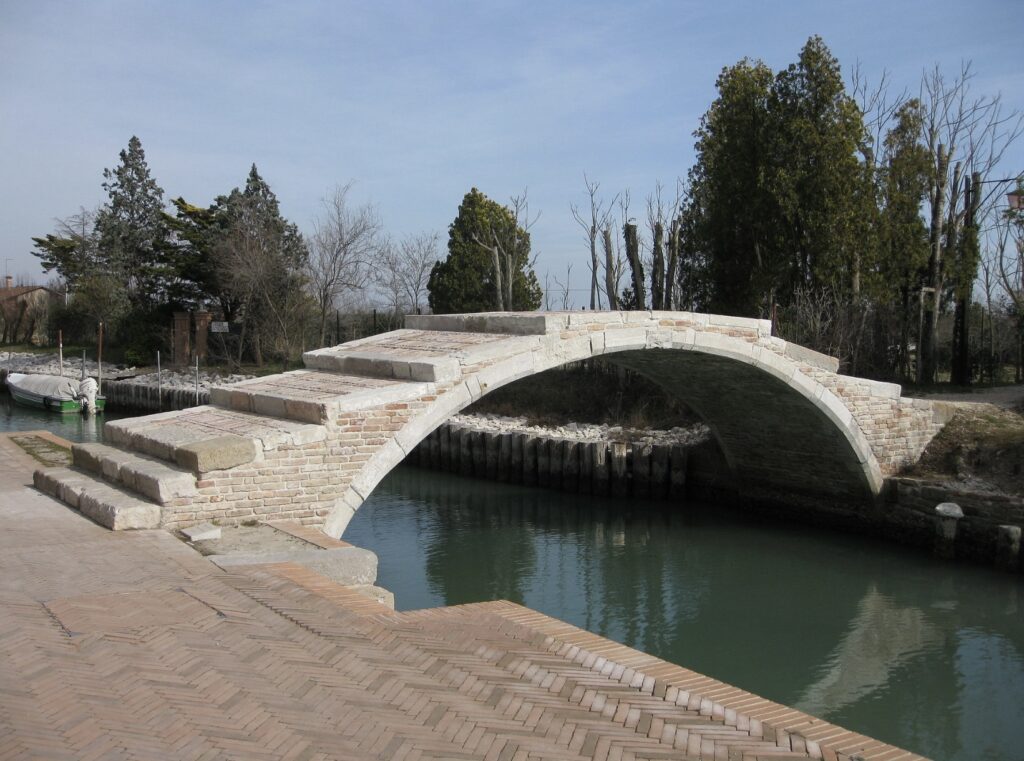
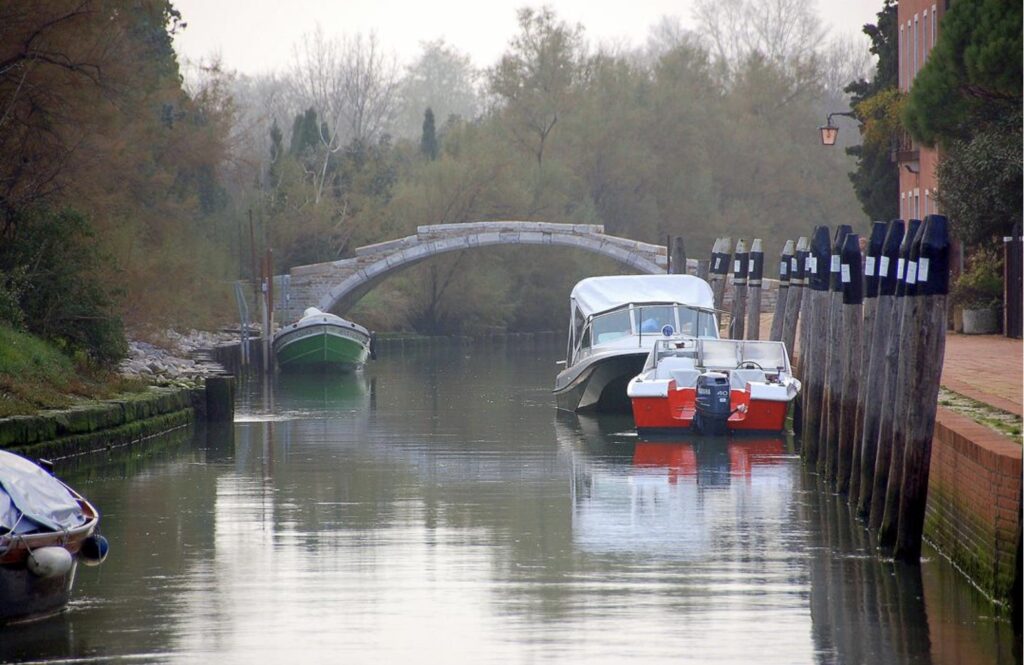
3. Attila’s Throne
- Description: Near the Basilica di Santa Maria Assunta, you’ll find a large stone chair known as “Attila’s Throne.” Despite the name, there is no evidence linking the throne to Attila the Hun. It is more likely that the throne was used by the island’s magistrate or bishop as a seat of authority. The throne is carved from a single block of marble and is a popular spot for visitors to sit and imagine the ancient rulers of Torcello.
4. Santa Fosca’s Portico
- Description: The arcaded portico that surrounds the Church of Santa Fosca is a peaceful place to walk and enjoy the island’s tranquil atmosphere. The portico provides shelter from the sun and rain, and its arches frame views of the surrounding gardens and the lagoon. It’s a lovely spot to relax and take in the historic ambiance of Torcello.
5. Torcello’s Natural Landscape
- Description: While not a specific site, the natural landscape of Torcello is one of its most appealing features. The island is surrounded by marshes and wetlands, which are home to a variety of bird species and other wildlife. Walking along the paths that crisscross the island, you can enjoy the peace and quiet of the countryside, far removed from the busy streets of Venice.
6. The Church of San Giovanni Evangelista
- Description: Though only ruins remain, the Church of San Giovanni Evangelista was once a significant religious site on the island. It dates back to the early Christian period and is one of the earliest churches in the Venetian Lagoon. The ruins offer a glimpse into the early days of Christianity in the region and are a poignant reminder of the island’s long history.
Torcello may be small, but it offers a wealth of historical, architectural, and natural sights that make it a fascinating destination. The island’s peaceful atmosphere and rich heritage provide a unique contrast to the more crowded areas of Venice, making it a perfect day trip for those interested in exploring the quieter, more historical side of the Venetian Lagoon.
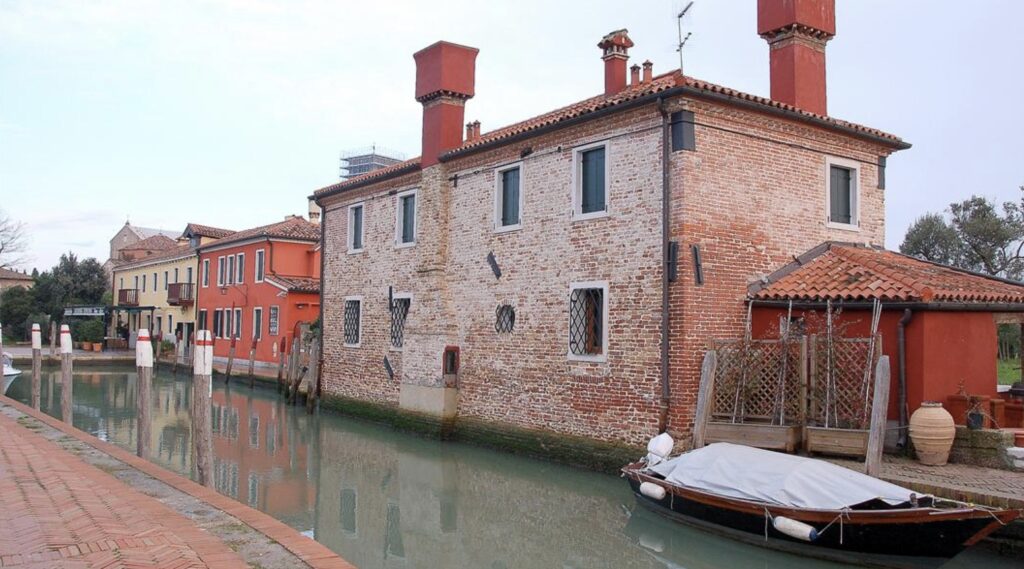
The islands around Torcello, including Burano and Mazzorbo, offer some pleasant walking trails that combine natural beauty with cultural and historical insights. Here are a few walking trails and paths you might explore:
1. Torcello Island Walk
- Distance: Approximately 2 kilometers
- Highlights: This easy walk takes you through the entire island of Torcello, allowing you to explore its key historical sites, including the Basilica di Santa Maria Assunta, the Church of Santa Fosca, the Museo Provinciale, and the Ponte del Diavolo. The trail is mostly flat and can be completed in under an hour, though you might want to take your time to appreciate the serene environment and historical landmarks.
2. Burano Island Loop
- Distance: Approximately 3 kilometers
- Highlights: Burano is famous for its brightly colored houses and lace-making tradition. A leisurely loop around the island will take you through the picturesque streets, along the canals, and to the main square, Piazza Galuppi. You can also visit the leaning bell tower of San Martino Church. The walk is flat and easy, perfect for a relaxing stroll while taking in the vibrant atmosphere.
3. Mazzorbo and Burano Walk
- Distance: Approximately 4 kilometers
- Highlights: Mazzorbo is connected to Burano by a wooden footbridge, and a walk combining both islands offers a blend of history, nature, and local culture. Start in Mazzorbo, where you can explore the tranquil vineyard of Venissa and the Church of Santa Caterina. After crossing the bridge, continue your walk through Burano, enjoying the colorful houses and charming canals. The route is flat and can be done at a leisurely pace, with plenty of opportunities to stop for photos and refreshments.
4. San Francesco del Deserto
- Distance: Short walks within the island (total island size is about 0.7 kilometers in length)
- Highlights: San Francesco del Deserto is a small, peaceful island located between Burano and Sant’Erasmo. It is home to a Franciscan monastery dating back to the 13th century. The island is not large, but you can enjoy a peaceful walk around the monastery’s grounds and through its small forested areas. The island is accessible by private boat, and visits are usually guided by the friars living there, adding a unique spiritual dimension to the experience.
5. Sant’Erasmo Island Walk
- Distance: 8-10 kilometers (depending on route)
- Highlights: Known as the “vegetable garden” of Venice, Sant’Erasmo is a larger island that offers a more extensive walk. You can explore the agricultural landscapes, vineyards, and orchards that supply Venice with fresh produce. Key sites include the Torre Massimiliana, a Napoleonic-era fortification, and various small farms where you can sample local products. The walk around the island is mostly flat, with paths winding through fields and along the lagoon’s edge.
These walking trails provide a great way to explore the less crowded, more tranquil parts of the Venetian Lagoon, offering a mix of natural beauty, history, and local culture. They are ideal for a relaxing day trip away from the hustle and bustle of Venice.
